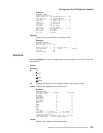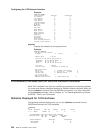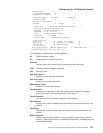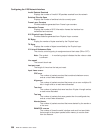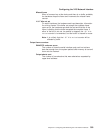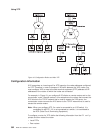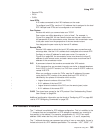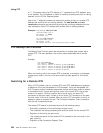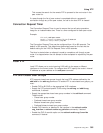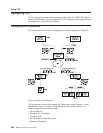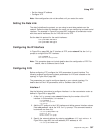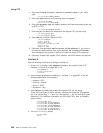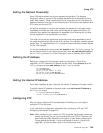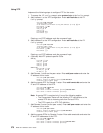
v Remote DTEs
v PVCs
v CUGs
Local DTEs
X.25 nodes connected to the X.25 interfaces on the router
To configure local DTEs, use the X.121 address that is assigned to the local
DTE. Multiple local DTEs can be configured on an interface.
Peer Routers
Routers with which you communicate over TCP/IP
Peer routers can differ depending on “point of view”. For example, in
Figure 19 on page 362, the
two remote routers
are the peer routers from
the perspective of the concentrator router. However, the
concentrator router
is the peer router from the perspective of the two remote routers.
You designate the peer router by its internal IP address.
Remote DTEs
Remote X.25 nodes to which the local X.25 nodes open connections and
exchange data. Use the X.121 address that is assigned to the remote DTE.
Configure a
unique
IP address for each peer router. For example, in
Figure 19 on page 362, the concentrator router must know the unique IP
address of each remote router, and each remote router must know the IP
address of the concentrator router.
PVC A permanent channel that remains connected after X.25 restarts.
PVCs, because they are constant channels, are similar to leased telephone
lines. A PVC, in the XTP context, is a PVC from a local X.25 DTE node to a
remote X.25 DTE.
When you configure a router for PVCs, map the IP address of the peer
router and the PVC number of the remote and local DTE. A PVC is
identified by four pieces of information which are the:
v Logical channel numbers of the local PVCs
v X.121 address of the local DTE
v Logical channel numbers of the PVCs on the remote (peer) router
v X.121 address of the remote DTE
CUGS The closed user groups for the XTP protocol. See “Understanding Closed
User Groups” on page 324.
Additional configuration information can be found at “Configuring XTP” on page 366
and at “XTP Configuring Commands” on page 375.
DTE Address Wildcards
The “*” wildcard is available for DTE address configuration. This is in addition to the
“?” character that can be specified in a DTE address to represent any one digit in
that position in the address. For example, a specification of “1?2?3” can match
address 18243 where the first, third, and fifth digits are 1, 2, and 3, respectively.
The “*” wildcard character can represent any string of zero or more digits. Its use is
limited to the end of a DTE address specification. For example: “123*”, “5555*”, “9*”
Using XTP
Chapter 28. Using XTP 363
|
|
|
|
|



